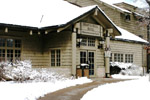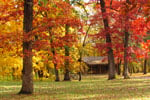IROQUOIS COUNTY STATE WILDLIFE AREA
Iroquois State Wildlife Area is situated in a low glacial outwash plain associated with the Kankakee River Valley that consists of marshland, sand ridges, and dunes. The initial acquisition of land occurred in 1944 for the purpose of protecting the declining prairie chicken population in the State. The prairie chickens did not survive and public hunting became the major use. The State purchased an additional 560 acres in 1984. Known as the Hooper Branch Savanna, 480 acres of this parcel is considered the largest single tract of rare native savanna remaining in Illinois. The total acreage is now 2,480.
The area is located two miles north and three miles east of Beaverville, in the extreme northeast corner of Iroquois County, about 80 miles south of Chicago. The majority of the area, 2,000 acres, is managed as a public hunting area. The remainder of the area is a dedicated nature preserve. Nonconsumptive recreation in the form of hiking and nature study is available when the facility is closed to hunting.
The Iroquois State Wildlife Area exhibits some of the finest and most extensive prairie marsh and sand dune vegetation remaining in Illinois. The occurrence of this vegetation is regulated by soil characteristics and moisture. The dry sand ridges are dominated by black oak forest. Lower lying areas range from dry prairie to marsh, depending on soil moisture. Dominant grasses on dry prairie areas are little bluestem and switch grass. Grasses such as big bluestem, Indian grass, little bluestem, and switch grass are dominant on mesic (intermediate between wet and dry) prairie. Areas of wet prairie are indicated by bluejoint grass, cord grass, and sedges. Several boggy areas contain plants seldom encountered elsewhere in Illinois. Among these are blueberry, huckleberry, hardhack, march marigold, colic root, sundew (a carnivorous plant), and primrose violet.
Aside from supporting huntable populations of deer and upland game, Iroquois State Wildlife Area is inhabited by numerous, interesting non-game birds and mammals. Wet prairies and marshes provide preferred habitat for birds such as herons, bitterns, rails, snipe, and marsh hawks. During migration, marshes are visited by numerous species of waterfowl and the rare sandhill crane. Mammals utilizing Iroquois? marshlands include raccoon, muskrat, mink, and beaver. Upland prairie and forest at Iroquois are inhabited by many species of songbirds. During migration the number of species that may be seen on the area is increased even further. The Veery, a rare thrush, is reported to nest in the area. Unusual mammalian species occupying the uplands include the plains pocket gopher and the southern flying squirrel.
Hooper Branch Savanna occupies the edge of former Glacial Lake Watseka. Fourteen thousand years ago this lake formed between moraines damming up glacial meltwaters. The soils of Hooper Branch Savanna are sandy, having derived from beach and nearshore sand deposits exposed to wind action. A dune and swale topography developed which is quite noticeable today.
Savanna developed on the dry dune ridges while shrub prairies and mesic sand prairies developed in the wetter swales. Savannas are composed of a mix of trees with prairie grasses and forbs. Savannas have a park-like appearance with widely spaced trees and little brush. Savannas are a fire maintained natural community. Periodic fires swept through this area prior to settlement killing small trees and shrubs but the thick bark of the large trees protected them from the fire. Black oaks are the dominant savanna trees at Hooper Branch Savanna with prairie grasses such as porcupine grass, june grass and little bluestem. Prairie forbs such as puccoons, lupines, leadplant, spiderwort, and butterfly weed provide color to the savanna landscape. In the shrub prairie portions, mosses carpet the sand surface.
A seasonal concession operates at the headquarters during the hunting season.
The area is operated primarily as a permit pheasant hunting area; however, there is rabbit, quail, and pheasant hunting on the area after the permit has been concluded. Prior to the permit portion of the hunting season, squirrel and dove provide the early hunting action. Deer hunting (bow only) is allowed on the area prior to and following the permit portion of the hunting season. Lesser opportunities for woodcock, rail, snipe and deer (shotgun) are also available. Check with the site superintendent for upland game species and hunting dates on the area.
1. During the permit pheasant season, all hunters mush check in and check out, before and after hunting, at the area headquarters.
2. Before and after the permit pheasant season, all hunters, must check out at the area headquarters after hunting.
3. Raccoon and opossum may be taken only with a special permit issued from the site superintendent.



